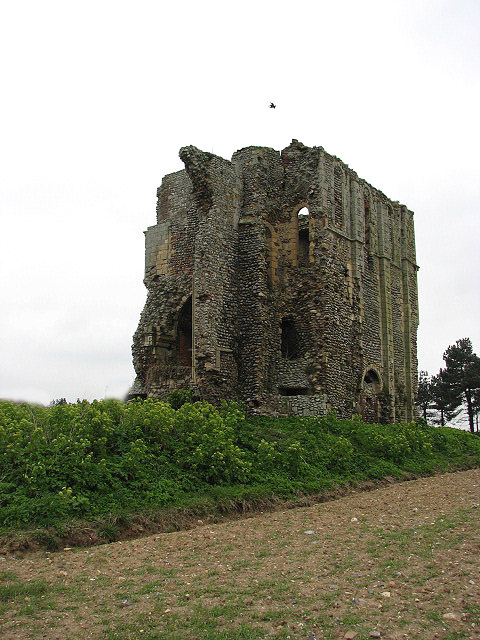Bromholm Priory on:
[Wikipedia]
[Google]
[Amazon]

 Bromholm Priory was a
Bromholm Priory was a
A Short History of Bromholm Priory
published 1911.

Cluniac
The Cluniac Reforms (also called the Benedictine Reform) were a series of changes within medieval monasticism of the Western Church focused on restoring the traditional monastic life, encouraging art, and caring for the poor. The movement began ...
priory
A priory is a monastery of men or women under religious vows that is headed by a prior or prioress. Priories may be houses of mendicant friars or nuns (such as the Dominicans, Augustinians, Franciscans, and Carmelites), or monasteries of ...
, situated in a coastal location near the village of Bacton, Norfolk
Norfolk () is a ceremonial and non-metropolitan county in East Anglia in England. It borders Lincolnshire to the north-west, Cambridgeshire to the west and south-west, and Suffolk to the south. Its northern and eastern boundaries are the Nor ...
, England
England is a country that is part of the United Kingdom. It shares land borders with Wales to its west and Scotland to its north. The Irish Sea lies northwest and the Celtic Sea to the southwest. It is separated from continental Europe ...
History
Bromholm Priory, also known as Bacton Abbey, was founded in 1113 by William de Glanville, Lord of Bacton, and was originally subordinate toCastle Acre Priory
Castle Acre Priory was a Cluniac priory in the village of Castle Acre, Norfolk, England, dedicated to St Mary, St Peter, and St Paul. It is thought to have been founded in 1089 by William de Warenne, 2nd Earl of Surrey (the son of the 1st Earl ...
until 1195 when it was exempted by Pope Celestine III. King Henry III visited the priory in 1223 to take the holy waters and dedicate to the relics; lands nearby were controlled by the all-powerful Justiciar Hubert de Burgh. From this priory we have the Bromholm Psalter dated to the early fourteenth century. The priory was suppressed in 1536. All that now remains are the ruins of the gatehouse, Chapter House, and the northern transept of the Priory Church.
It was an important object of pilgrimage as it claimed to possess a piece of the True Cross
The True Cross is the cross upon which Jesus was said to have been crucified, particularly as an object of religious veneration. There are no early accounts that the apostles or early Christians preserved the physical cross themselves, althoug ...
, mentioned as the 'holy cross of Bromeholme' in Chaucer's ''The Reeve's Tale
"The Reeve's Tale" is the third story told in Geoffrey Chaucer's '' The Canterbury Tales''. The reeve, named Oswald in the text, is the manager of a large estate who reaped incredible profits for his master and himself. He is described in the ...
'' and William Langland
William Langland (; la, Willielmus de Langland; 1332 – c. 1386) is the presumed author of a work of Middle English alliterative verse generally known as ''Piers Plowman'', an allegory with a complex variety of religious themes. The poem tr ...
's ''Vision of Piers Plowman
''Piers Plowman'' (written 1370–86; possibly ) or ''Visio Willelmi de Petro Ploughman'' (''William's Vision of Piers Plowman'') is a Middle English allegorical narrative poem by William Langland. It is written in un- rhymed, alliterati ...
''.
It was a benefice of the Paston family and is featured in their letters
Letter, letters, or literature may refer to:
Characters typeface
* Letter (alphabet), a character representing one or more of the sounds used in speech; any of the symbols of an alphabet.
* Letterform, the graphic form of a letter of the alpha ...
.
In 1940 the base of the central tower of the priory church was modified to act as a pillbox in case of German invasion.
Considerable graphic visualisations of what the priory and its lands looked like throughout its history were produced in 2019 and 2020 by members of the Paston Portal.Paston Portal URL: https://www.thisispaston.co.uk/bromholm01.html Date accessed: 14 February 2022
A Short History of Bromholm Priory
published 1911.
References
* British History Online (2003-5). ''Houses of Cluniac monks — The priory of Bromholm''. Retrieved 7 December 2005. Cockerell, Sydney Carlyle, Sir. Two East Anglian psalters at the Bodleian library. Oxford: Printed for the Roxburghe Club by J. Johnson, 1926. (Facsimile of Bolmholm Psalter) Cluniac monasteries in England Monasteries in Norfolk 1113 establishments in England 1536 disestablishments in England Religious organizations established in the 1110s Grade I listed buildings in Norfolk Christian monasteries established in the 12th century Order of Saint Benedict {{RC-stub